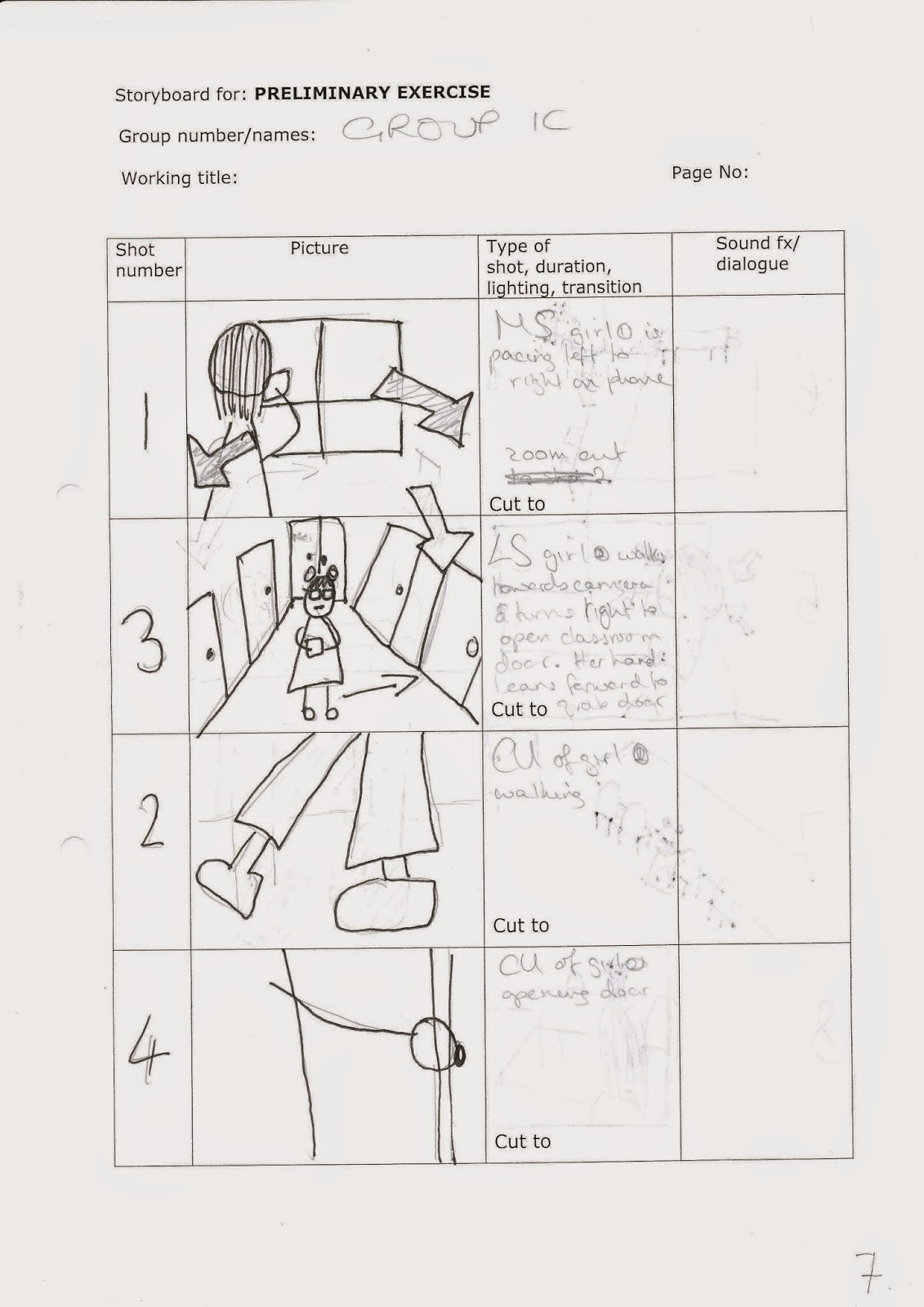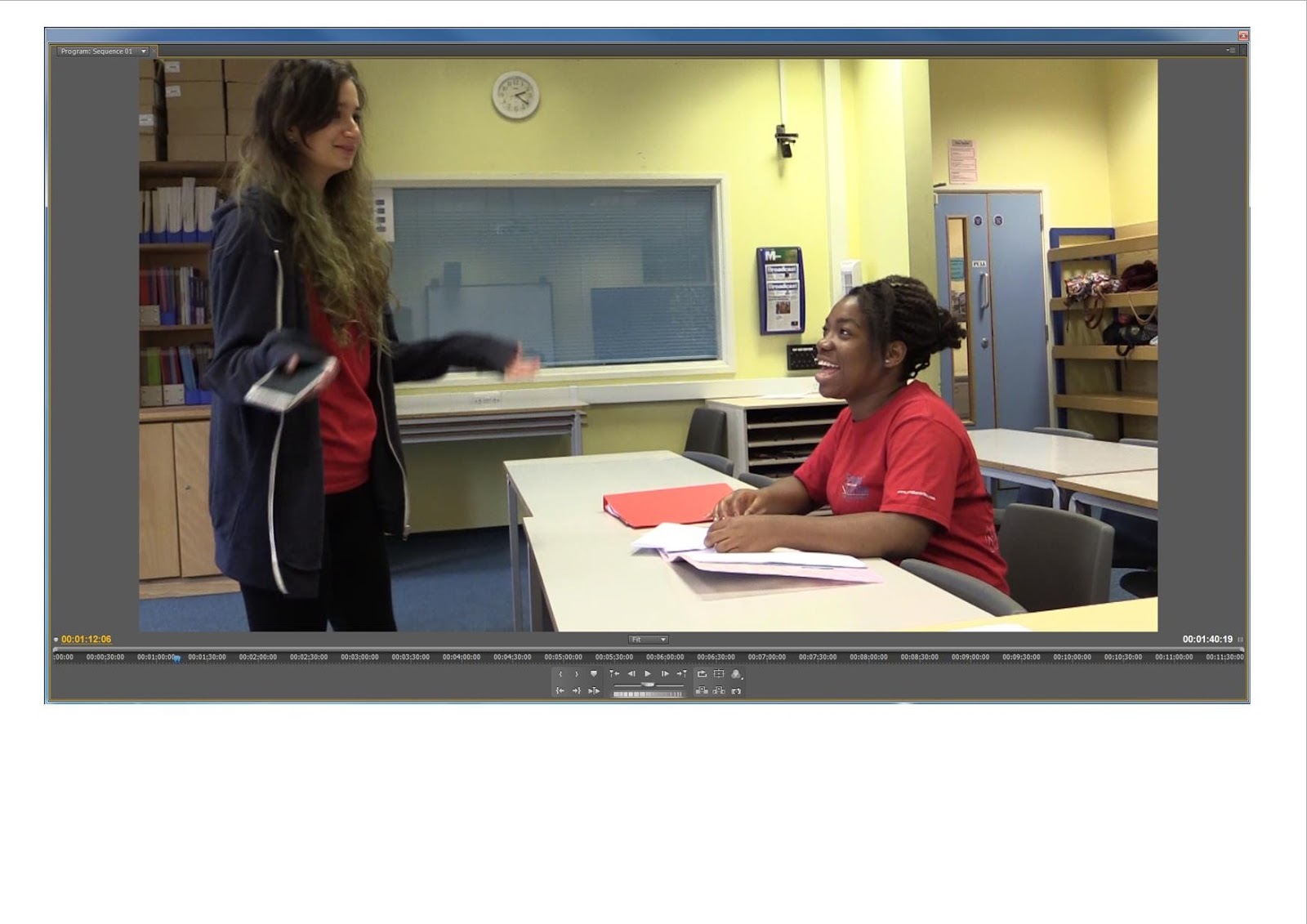 This was the group with which I worked. I am on the left, Shayam in the middle and Godgift on the right. We managed the task well between the three of us by clearly dividing the planning and shooting work evenly, helping us to work quickly and efficiently. I then did my own edit of the footage.
This was the group with which I worked. I am on the left, Shayam in the middle and Godgift on the right. We managed the task well between the three of us by clearly dividing the planning and shooting work evenly, helping us to work quickly and efficiently. I then did my own edit of the footage.How did you plan your sequence? What processes did you use?What theories did you try to take into account?
 Initially we started to plan our sequence by brain storming a few ideas and managed to come up with 2 different plausible sequences. After this we
Initially we started to plan our sequence by brain storming a few ideas and managed to come up with 2 different plausible sequences. After this were-analysed the both plots and decided upon the one we thought would be most effective and could convey its genre well though a short sequence. We then drew up a rough shot list and chose the costumes for our characters that would easily connote the stereotypical roles they represent (a popular girl and a geek). Then, we designating jobs to each of us, Godgift created a storyboard, depicting our ideas from the shot list. Shayam created a shoot schedule, which included timing, props and the costumes needed, whilst I created a script and space plan for the sequence. We then arranged a meeting in which we went over the three processes that we used and tried to visualise the camera positioning and check that no continuity rules such as the 180 degree rule and the 30 degree rule had been broken.
What technology did you use to complete the task, and how did you use it?
 During this task we used a variety of technology. Firstly, the camera that we filmed our sequence on was a Canon Legria HFG30, with a high quality microphone, seen in the picture to the left. We had this on top of a tripod that allowed us to pan smoothly and experiment with different levels. Along side these technologies we also used a clapper board, which we filmed at the beginning of each shot for easy recognition when editing the cuttings, and headphones which were used to make sure the sound levels were correct. After this, for editing, we
During this task we used a variety of technology. Firstly, the camera that we filmed our sequence on was a Canon Legria HFG30, with a high quality microphone, seen in the picture to the left. We had this on top of a tripod that allowed us to pan smoothly and experiment with different levels. Along side these technologies we also used a clapper board, which we filmed at the beginning of each shot for easy recognition when editing the cuttings, and headphones which were used to make sure the sound levels were correct. After this, for editing, we used Adobe Premiere which is a professional editing software that allowed us to create invisible cuts between our shots and helped remove any continuity errors.
used Adobe Premiere which is a professional editing software that allowed us to create invisible cuts between our shots and helped remove any continuity errors.What factors did you have to take into account when planning, shooting and editing?

From the beginning of our task we were all quick to notice that there were clear limitations to what we had been asked to do and therefore were big factors that needed to be taken into consideration when executing the task. For example, the time limitations meant that we had to plan a sequence that was short and simple and that we could easily film in 1 hour. It also meant that we had to plan our shoot strictly with timings throughout and that in editing we could not afford to try create special effects or even introduced new sound, meaning that we had to make sure we would be able to connote our genre clearly and carefully through the filming and avoid any continuity errors that could cause a problem when editing. Another limitation was the surroundings and props that we had on offer, this meant that it was important to incorporate our school setting and plan a story line and genre to compliment that. Finally, we also had to take into account the camera and character positioning when planning, shooting and editing. This is so that we could make sure that the camera was only filming the conversation on one side of an imaginary axis linking the two characters, in order to stick to the 180 degree rule and also so that we could create a impressive match on action and avoid any jump cuts (30 degree rule).
How successful was your sequence? Please identify what worked well, and with hindsight, what you would improve/do differently?
Overall I think that our sequence was quite successful. This is because we did manage to create a smooth final edit that contained 2 matches on action, no jump cuts and invisible cuts between shots. I also think that the acting was strong and we were able to covey the genre of a teen-comedy drama well. As well as this I think that we used a large range of angles and levels and managed to use a shot reverse shot in the conversation. However, despite the positives, I also think there were a lot of things we could have done better. For example, we only used the clapper board in the second half of our shoot, as, due to lack of organisation we forgot to get one until reminded. We also ended up not following our schedule and storyboard very effectively as we thought of new ideas during the shoot and also underestimated the amount of time for each shot. Lastly, we didn't plan enough in certain areas; in our second shoot session we forgot one of the props (The geeks glasses) which limited us to the number of retakes we were able to take to ensure continuity.
What have you learnt from completing this task? Looking ahead, how will this learning be significant when completing the rest of your foundation coursework, do you think?
 I think that this task has been extremely beneficial to my learning. This is because I now understand the importance of planning out your sequence in detail before the shoot and accurately judging the timings that will be needed for each shot, but also to allow time for extra ideas that I may want to incorporate later on. This is because otherwise you will end up improvising on the spot and are likely to come away with many continuity errors and therefore a badly flowing sequence. Therefore for the rest of my foundation coursework I will make sure that all my shots and timing and props have be planned thoroughly beforehand. Secondly, I have learnt that it is best to keep all the props used, in the building between shoots because otherwise props can be forgotten creating continuity errors, which is what happened to us when the 'geek's' glasses were forgotten and therefore, on the second shoot the shots we could retake were extremely limited.
I think that this task has been extremely beneficial to my learning. This is because I now understand the importance of planning out your sequence in detail before the shoot and accurately judging the timings that will be needed for each shot, but also to allow time for extra ideas that I may want to incorporate later on. This is because otherwise you will end up improvising on the spot and are likely to come away with many continuity errors and therefore a badly flowing sequence. Therefore for the rest of my foundation coursework I will make sure that all my shots and timing and props have be planned thoroughly beforehand. Secondly, I have learnt that it is best to keep all the props used, in the building between shoots because otherwise props can be forgotten creating continuity errors, which is what happened to us when the 'geek's' glasses were forgotten and therefore, on the second shoot the shots we could retake were extremely limited.




No comments:
Post a Comment